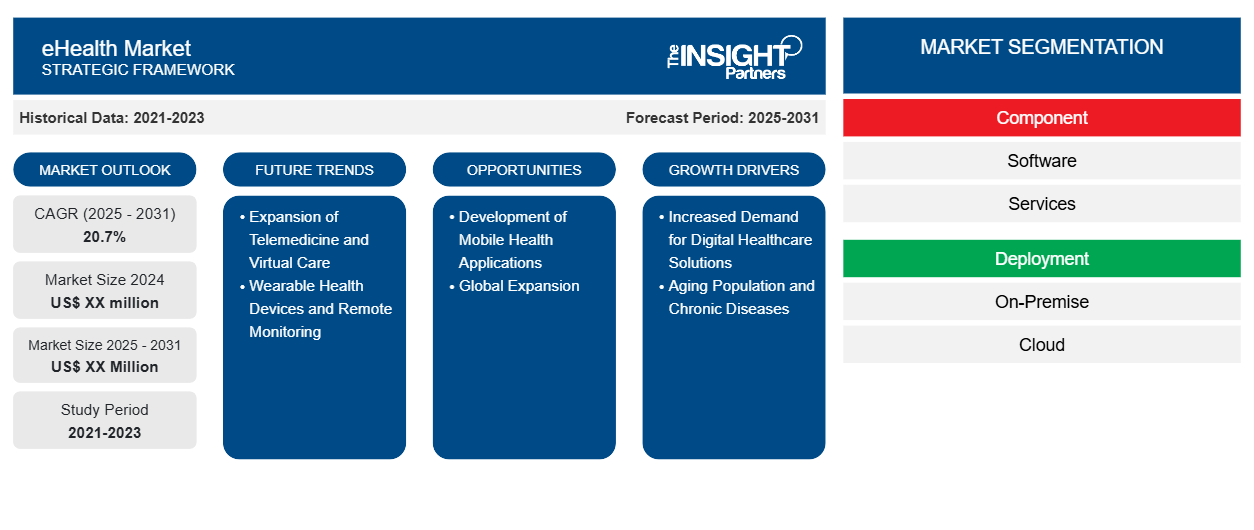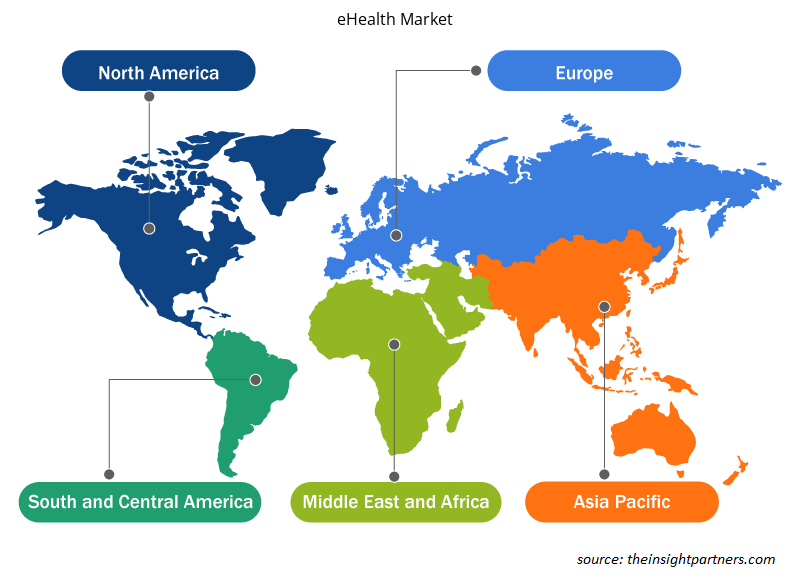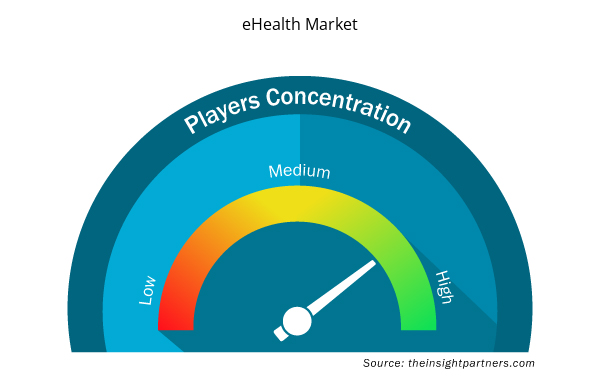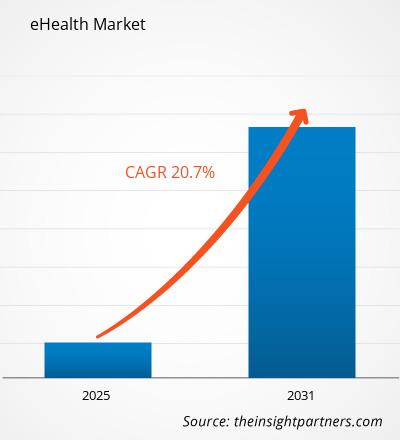The eHealth Market is expected to register a CAGR of 20.7% from 2025 to 2031, with a market size expanding from US$ XX million in 2024 to US$ XX Million by 2031.
The report is segmented by Component {Software (Electronic Health Records, e-Prescribing, Clinical Decision Support Systems, Telemedicine, and Other Components), Services}; Deployment (On-Premise, Cloud), End User (Healthcare Providers, Payers, Healthcare Consumers, and Others). The global analysis is further broken-down at regional level and major countries. The report offers the value in USD for the above analysis and segments
Purpose of the Report
The report eHealth Market by The Insight Partners aims to describe the present landscape and future growth, top driving factors, challenges, and opportunities. This will provide insights to various business stakeholders, such as:
- Technology Providers/Manufacturers: To understand the evolving market dynamics and know the potential growth opportunities, enabling them to make informed strategic decisions.
- Investors: To conduct a comprehensive trend analysis regarding the market growth rate, market financial projections, and opportunities that exist across the value chain.
- Regulatory bodies: To regulate policies and police activities in the market with the aim of minimizing abuse, preserving investor trust and confidence, and upholding the integrity and stability of the market.
eHealth Market Segmentation
Component
- Software
- Services
Deployment
- On-Premise
- Cloud
End User
- Healthcare Providers
- Payers
- Healthcare Consumers
Geography
- North America
- Europe
- Asia Pacific
- Middle East and Africa
- South and Central America
Customize This Report To Suit Your Requirement
You will get customization on any report - free of charge - including parts of this report, or country-level analysis, Excel Data pack, as well as avail great offers and discounts for start-ups & universities
eHealth Market: Strategic Insights

- Get Top Key Market Trends of this report.This FREE sample will include data analysis, ranging from market trends to estimates and forecasts.
eHealth Market Growth Drivers
- Increased Demand for Digital Healthcare Solutions: The demand for digital healthcare solutions has increased because healthcare has become more patient-centric and data-driven. eHealth technologies are becoming increasingly adopted in countries as a means of improving the patient experience.
- Aging Population and Chronic Diseases: With a rising global life expectancy, many elderly suffer from chronic diseases. This demographic shift necessitates more efficient healthcare solutions, which eHealth can provide.
eHealth Market Future Trends
- Expansion of Telemedicine and Virtual Care: The adoption of telemedicine and virtual healthcare services is poised to grow significantly, driven by advancements in digital communication technologies and the increasing demand for convenient and accessible healthcare. In the future, telehealth platforms will become more integrated with other eHealth solutions, allowing for seamless consultations, remote monitoring, and access to healthcare providers across various specialties. AI-powered chatbots, remote diagnostics, and virtual health assistants will further enhance patient experiences, providing personalized care while reducing the strain on traditional healthcare systems. Telemedicine will also expand into mental health services, rehabilitation, and chronic disease management, enabling more people to access healthcare from the comfort of their homes.
- Wearable Health Devices and Remote Monitoring: The use of wearable devices and remote monitoring tools will continue to rise, enabling continuous tracking of vital health metrics such as heart rate, blood pressure, glucose levels, and sleep patterns. These devices will increasingly be integrated with cloud-based platforms, allowing healthcare providers to remotely monitor patient data in real-time and intervene when necessary.
eHealth Market Opportunities
- Development of Mobile Health Applications: The medical apps segment is one of the highest contributors to the eHealth market, indicating a significant opportunity for developers to create innovative health management applications.
- Global Expansion: As more countries recognize the benefits of eHealth, there are vast opportunities for market expansion, particularly in developing regions where healthcare access is limited.
eHealth Market Regional Insights
The regional trends and factors influencing the eHealth Market throughout the forecast period have been thoroughly explained by the analysts at Insight Partners. This section also discusses eHealth Market segments and geography across North America, Europe, Asia Pacific, Middle East and Africa, and South and Central America.

- Get the Regional Specific Data for eHealth Market
eHealth Market Report Scope
| Report Attribute | Details |
|---|---|
| Market size in 2024 | US$ XX million |
| Market Size by 2031 | US$ XX Million |
| Global CAGR (2025 - 2031) | 20.7% |
| Historical Data | 2021-2023 |
| Forecast period | 2025-2031 |
| Segments Covered |
By Component
|
| Regions and Countries Covered | North America
|
| Market leaders and key company profiles |
eHealth Market Players Density: Understanding Its Impact on Business Dynamics
The eHealth Market market is growing rapidly, driven by increasing end-user demand due to factors such as evolving consumer preferences, technological advancements, and greater awareness of the product's benefits. As demand rises, businesses are expanding their offerings, innovating to meet consumer needs, and capitalizing on emerging trends, which further fuels market growth.
Market players density refers to the distribution of firms or companies operating within a particular market or industry. It indicates how many competitors (market players) are present in a given market space relative to its size or total market value.
Major Companies operating in the eHealth Market are:
- Athenahealth, Inc.
- Cisco Systems, Inc.
- GENERAL ELECTRIC COMPANY
- Koninklijke Philips N.V.
- Siemens Healthcare Private Limited
Disclaimer: The companies listed above are not ranked in any particular order.

- Get the eHealth Market top key players overview
Key Selling Points
- Comprehensive Coverage: The report comprehensively covers the analysis of products, services, types, and end users of the eHealth Market, providing a holistic landscape.
- Expert Analysis: The report is compiled based on the in-depth understanding of industry experts and analysts.
- Up-to-date Information: The report assures business relevance due to its coverage of recent information and data trends.
- Customization Options: This report can be customized to cater to specific client requirements and suit the business strategies aptly.
The research report on the eHealth Market can, therefore, help spearhead the trail of decoding and understanding the industry scenario and growth prospects. Although there can be a few valid concerns, the overall benefits of this report tend to outweigh the disadvantages.
- Historical Analysis (2 Years), Base Year, Forecast (7 Years) with CAGR
- PEST and SWOT Analysis
- Market Size Value / Volume - Global, Regional, Country
- Industry and Competitive Landscape
- Excel Dataset



Report Coverage
Revenue forecast, Company Analysis, Industry landscape, Growth factors, and Trends

Segment Covered
This text is related
to segments covered.

Regional Scope
North America, Europe, Asia Pacific, Middle East & Africa, South & Central America

Country Scope
This text is related
to country scope.
Frequently Asked Questions
Some of the customization options available based on the request are an additional 3–5 company profiles and country-specific analysis of 3–5 countries of your choice. Customizations are to be requested/discussed before making final order confirmation#as our team would review the same and check the feasibility
The report can be delivered in PDF/PPT format; we can also share excel dataset based on the request
Increased demand for digital healthcare solutions and aging population and chronic diseases are the major factors driving the eHealth market.
Expansion of virtual care and focus on preventive healthcare are likely to remain a key trend in the market.
The eHealth Market is estimated to witness a CAGR of 20.7% from 2024 to 2031
Trends and growth analysis reports related to Technology, Media and Telecommunications : READ MORE..
The List of Companies
1. General Electric Company
2. Cerner Corporation
3. Koninklijke Philips N.V.
4. Mckesson Corporation
5. Siemens AG
6. athenahealth, Inc.
7. CompuMed, Inc.
8. McKinsey & Company
9. Medtronic
10. Cisco Systems, Inc.
11. MEDHOST
12. INTERSYSTEMS CORPORATION
13. CANTATA HEALTH
14. BIOTELEMETRY, INC.
15. IHEALTH LAB, INC.

 Get Free Sample For
Get Free Sample For